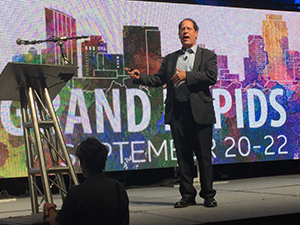 Bruce Katz has poured his years of experience dealing with the challenges and opportunities of global urbanization into his latest book, The New Localism: How Cities Can Thrive in the Age of Populism. At Convention, he shared some of the issues and ideas he covers in the book.
Bruce Katz has poured his years of experience dealing with the challenges and opportunities of global urbanization into his latest book, The New Localism: How Cities Can Thrive in the Age of Populism. At Convention, he shared some of the issues and ideas he covers in the book.
In recent years, globalization and rapid technological advancements have changed just about everything in our country, including how government operates. Cities and regions – more so than the federal government – are now the drivers of the economy. Power is shifting downward and horizontally, from government alone to multi-disciplinary groups including public, private and civic partnerships.
To adapt to the changes, governments need a new set of norms for growth, governance, and finance. Katz shared some examples from his book.
Growth
Thirty years ago, Pittsburgh was struggling due to loss of industries. Today, the city is home to Uber and many other international companies. They decided they wanted to manage the city’s growth rather than it’s decline. The city capitalized on all the universities and philanthropic organizations in their area and acted like an entrepreneur willing to take risks in order to draw in talent and business. Now “brainbelt” is a more apt description of the city than “rustbelt.”
Governance
In the 1970s, nothing was going on in downtown Indianapolis. To be a great city, city leaders decided they needed to restore the core and everything would radiate out from there. Their plan involved becoming the country’s amateur sports capital. They brought together the pubic and private sectors and created Indiana Sports Corp to move their vision forward. After realizing their amateur sports goal, they applied the same public-private collaborative model to the bio-tech industry. Indianapolis is now the second biggest exporter of bio technology.
Finance
Copenhagen, Denmark was on the verge of bankruptcy in the 1980s. City leaders decided that the key to reviving their city was to build a 21st century transit system. But how could they do that without taxing their burdened citizens? They took advantage of their public wealth – the land and buildings the city already owned. They placed valuable city-owned land near the airport and harbor into the hands of a publicly owned, professionally managed corporation. And they stuck to one very important rule – all revenue derived from redeveloping the city-owned property would be used for the sole purpose of servicing the debt on the transit system. Copenhagen is now a very successful city with an enviable transit system.
Power has shifted downward and it’s not going back. So to be a problem solver in today’s economy, your community needs to answer these questions:
- What’s your edge? Identify your place in the new economy.
- Who’s in charge? Defined the leaders who make up your network
- Where’s your power? Audit and stress-test your local institutions
To purchase Bruce Katz’ book, The New Localism: How Cities Can Thrive in the Age of Populism, click here.
